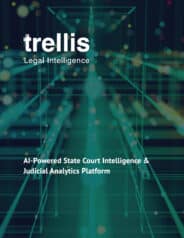Keeping up on the litigation landscape with AI-powered legal analytics can help cultivate productive and meaningful client relationships.
“As someone who had his own law firm, I learned very early on that without clients, you had no business,” says Cole Silver, Chief Client Officer at Blank Rome. The statement is as bold as it is obvious. Still, it bears repeating. We all know that operating a law firm involves more than just practicing law. There is also the business behind the law. That is, all of the labor involved in marketing and managing client relationships.
The business of the law requires a certain set of skills, as legal markets are generally soft, filled with more sellers than buyers. There are myriad ways to cultivate connections with prospective clients. Some legal teams rely on networking — meeting the right people, and fostering the right reputation. Others place their trust in marketing campaigns, scooping up space on highway billboards, television programs and radio voiceovers.
But what if there was another way?
The First Ping
For Christian Mammen, a partner at Hogan Lovells, it all starts with an alert. Mammen describes a practice many commercial litigators use to tap into new business opportunities. Legal analytics platforms like Trellis and Bloomberg Law enable litigators to register for alerts that notify them whenever a new case is filed against a company in their field of expertise. As soon as one of these alerts ping, a deluge of calls floods the in-house legal teams of the affected company. These calls often contain pitches, snippets of advice on venue and strategy, as well as commitments to provide the best possible defense.
With an alert system in place, legal analytics platforms offer a bird’s-eye view of the litigation landscape. A lawyer can watch events unfold in real-time, following players on both sides of the bench.
Some law firms have amended these alerts also to track local governments and administrations to monitor the ramifications of new policies and procedures. Others use alerts to spot emerging legal trends, relying on pings to help them keep abreast of the latest judicial rulings on a pivotal topic. With registered alerts on a legal analytics platform, litigators can stay proactive. They can anticipate problems that have not yet arisen, keeping prospective clients in the loop about unfolding events and the plans they have developed to protect their particular interests.
But what happens after the ping? How, exactly, can a lawyer convince a prospective client that their law firm is the best law firm? How can a lawyer show they have the experience, the expertise and the skills needed to efficiently and effectively handle a prospective client’s legal matters?
Ping to Pitch
It hasn’t always been easy for lawyers to quantify their relevant experience. In the past, a lawyer might prepare a pitch by consulting the most senior individuals in a law firm. “You would walk down the hall and talk to the person with the most gray hair and find out what their experience was with a particular judge,” begins Jeffrey Dailey, a former partner at Akin Gump. “Or somebody with really specific experience in a particular area and what has been their experience, what arguments seem to resonate with judges.” This modus operandi favored larger firms, tipping the playing field toward legal outfits with access to the largest sample pool of “anecdata.”
Legal analytics platforms provide another place to start, one that can help attorneys pack their pitches with more than just vague references to intuition or experience. Legal analytics is powered by the rich streams of data produced by legal professionals every single day. Trellis, for example, has curated a searchable archive of state trial court records for 16 states. By searching through this database, attorneys can learn the ins and outs of the individuals involved in any legal matter, searching through — and collecting information about — virtually any variable of their choosing.
Across the country, law firms both big and small, are taking advantage of this information, using hard data to quantify their relevant experience and court new clients. A standard pitch deck now includes charts and graphs — easy-to-grasp visualizations that demonstrate how law firms compare with their competitors. And according to Douglas Lancet, Managing Director of Marketing and Business Development at Robins Kaplan, this is what prospective clients want. They want to see that you have handled “similar cases with the same allegations involving the same technology or product [or] similar underlying facts.”
- How many times has your law firm handled certain types of cases?
- How long do your cases typically last?
- How do those numbers compare with competing law firms?
All of these questions can be answered with exact numbers — precise figures culled from thousands of data points from court dockets, documents and rulings. This information can be fed into pricing and strategy proposals. It can be used to walk prospective clients through each step of an impending case, providing realistic probabilities for different types of case outcomes. With legal analytics, these probabilities can then be contextualized with close readings of judicial rulings.
- Do specific judges or venues tend to deny motions to dismiss at high rates?
- Do these high rates reflect judicial biases against particular legal issues?
- Or do they speak to the idiosyncrasies of the individual cases passing through the docket?
The information is there.
Turning a Pitch into a Relationship
“Anticipating client needs has always been a key component of good lawyering,” observes Mary Che, Vice President of Marketing at Connell Foley. At the end of the day, a prospective client wants to know their attorney understands their world and their industry, and that their insights align with what they have experienced.
AI-powered legal analytics is the secret behind cultivating productive and meaningful client relationships. Attorneys can quickly get a feel for the litigation histories of their clients — the types of cases they have filed, the types of matters they have challenged and the types of outcomes they have achieved. Attorneys can see what worked, what didn’t work, what could have worked. It’s all written in the numbers.
But legal analytics also goes beyond numbers. Numbers can be a convincing way to get your law firm in the door, but they aren’t always what is needed to keep the door open. Gathering and retaining clients requires ascertaining the needs behind the numbers and the alerts, needs you can only learn through meaningful conversations, careful listening, and open dialogue. The numbers derived from legal analytics are just a starting point, a fruitful way to begin these discussions. What will you start talking about?
 About Trellis
About Trellis
Trellis is an AI-powered legal research and analytics platform that gives state court litigators a competitive advantage by making trial court rulings searchable and providing insights into the patterns and tendencies of your opposing counsel, and your state court judges.
Want to learn more? Click here to download the Trellis guide to using AI-powered state court intelligence in your practice.
























